Naga Sai Mandir
Tags : Temple
Timings : 5:00 AM - 1:00 PM and 4:00 PM - 9:00 PM
Entry Fee : No entry fee
Naga Sai Mandir, Coimbatore Overview
Naga Sai Mandi is dedicated to Sai Baba and is a famous attraction for the believers and followers of Sai Baba. This is one of the few temples of Sai Baba found in the southern part of the country. Devotees flock in large numbers to offer their prayers, especially on Sundays and Thursdays - the days deemed auspicious by the followers. The temple complex houses the sanctum sanctorum of Sai Baba and smaller shrines dedicated to other Hindu Gods. It is a perfect place to spend some time in peace. Devotees visiting the temple feel blessed at the sight of the divine idol of Sai Baba seen under the Adishesha.
The temple has a hall where devotees gather to sing devotional songs or bhajans. The bhajans are usually followed by the sacred aartis. All the devotees get Prasad after every pooja which is cooked in clean and hygienic environments. It is believed that Sai Baba fulfils all the wishes asked with a clean heart. The well maintained and well-thought temple complex has all the facilities to make the devotees feel at ease, sit and meditate or chant in the name of Sai Baba who is also called Sri Naga Sai. Believers are sure to find a trip to the attraction worthwhile.
Read More on Naga Sai Mandir
How To Reach Naga Sai Mandir
Golden Chariot and Dhuni at Naga Sai Temple

The Golden Chariot with an idol of Sri Sai Baba made in gold is taken care of by the Sri Naga Sai Trust. The Golden Chariot is also called Thanga Ther and was dedicated to Sai Baba on the 6th of June 2007. Every Thursday at 7:00 PM, the Chariot, decorated with flowers and garlands, is brought around the prakaram with great fanfare. The chariot is placed on wheels which make it easier to transport it. It is made of gold and has two galloping horses in the front, an intricately carved dome that rests on four pillars. A golden idol of Sai Baba is placed on a raised platform. A beautifully carved Naaga (Cobra) can be seen atop the dome.
Dhuni is the fire which was created by Sai Baba for the first time. It is also called the sacred Dhuni Flame. The flame has been transported to Sri Naga Sai Temple very carefully from a Sai Baba Mandir in Bangalore and is always kept ignited. Sai Baba often gave all his devotees udi or the ash from the flame. The practice is followed till date and devotees either put a tilak on the forehead of the udi or keep a tiny bit of it in the mouth. Consuming the udi is considered to be highly beneficial and is believed to cure illness.
History of Sri Naga Sai Temple

Coimbatore witnessed a movement in 1939 to establish the first institution dedicated to Sai Baba in the state. After the establishment of the institution, in 1942, a place of worship for devotees was opened in Mettupalayam road and was called Sai Baba Madam. A schedule for singing devotional songs was held every week on Sundays and Thursdays.
During one such Thursday, while the devotees were singing devotional songs with cymbals and drums, a Cobra happened to linger at the location of the activity. It just stayed there swinging, hypnotised with the music, and without attacking or scaring anyone around. The devotees thought of him as a messenger of Sai Baba and offered him flowers. When the devotees were unable to see the Cobra, they prayed for it to come out and it did. When they wished to go about their rituals, they prayed for the Cobra to leave and surprisingly, it left without scaring anyone around. Since then the temple is known as the Sri Naga Sai Temple.
